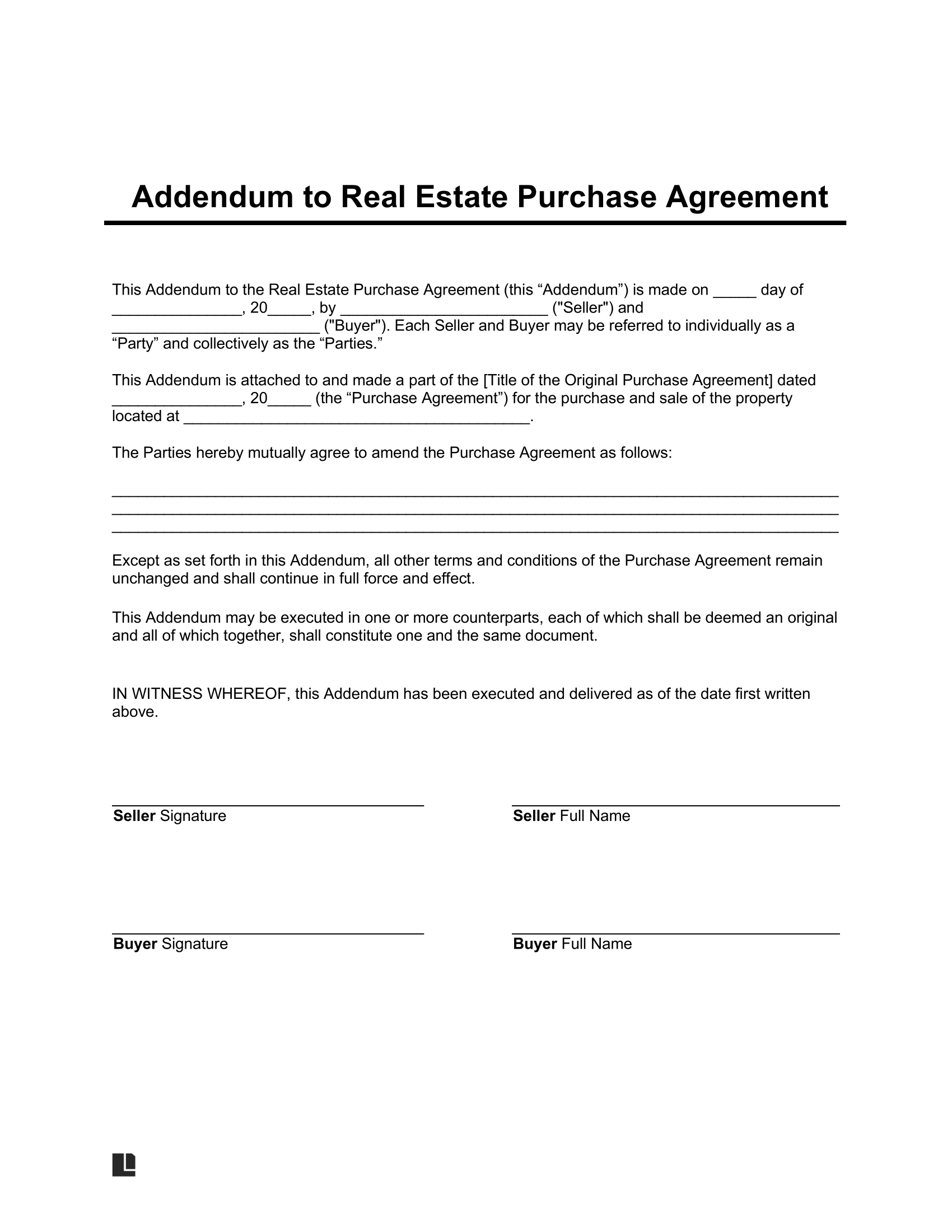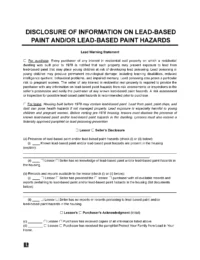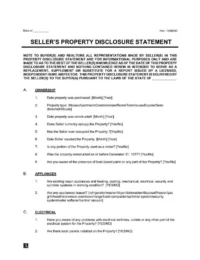A real estate purchase agreement addendum adds to a real estate purchase and sale agreement, expanding on the contract terms before or after the parties execute the original agreement.
An addendum is a legally binding change to the purchase contract, so you must handle it correctly for it to be enforceable.
What Is an “Addendum” In Real Estate?
An addendum to a real estate purchase agreement is a legal form that documents additions to the original purchase contract. It usually addresses information or terms the parties neglected to describe in the original contract. Buyers and sellers can propose addendums before or after signing the original contract, depending on their needs and the circumstances.
Once the parties write the purchase addendum, they attach it to the real estate purchase agreement to note supplementary additions or changes. Sellers, buyers, and real estate agents must adequately document all modifications to a purchase agreement to be legally enforceable.
Remember that an addendum does not replace the existing contract; it only adds to or clarifies certain aspects of the purchase agreement. If an addendum contradicts a statement in the original contract, the addendum will usually prevail because it’s the most recent mutual understanding between the parties.
Types of Addendums in Real Estate
Explore the different types of addendums you may need to add to a purchase agreement in the real estate industry:
Earnest Money Deposit Addendum
- When to Use: Use an earnest money deposit addendum to include details for holding, releasing, or forfeiting the money a buyer provides to show their intention to buy property.
- How to Use: Specify the deposit amount, the party holding the deposit (like an escrow agent or real estate brokerage), and the conditions under which the deposit will go to the seller or back to the buyer.
Inspection Addendum
- When to Use: Use an inspection addendum when the buyer wants to have a professional inspector inspect the property within a certain timeframe after the seller accepts the offer.
- How to Use: Clarify the types of inspections a buyer wants for the property (such as a pest, radon, or general home inspection) and the completion timeframe.
Escrow Holdback Addendum
- When to Use: Use an escrow holdback addendum whenever a seller needs to hold back some of their proceeds from real estate transactions to cover repair or improvement costs after the closing is finished.
- How to Use: Include a description of the required work, the dollar amount held in escrow, the party responsible for completing the necessary work, the timeline for completion, the procedure for releasing the funds, and the consequences of non-completion.
Estoppel Certificate Addendum
- When to Use: Use this addendum when the buyer wants to verify the terms and status of existing leases because it can give them more confidence when purchasing commercial or residential rental properties.
- How to Use: State the buyer’s requirement for estoppel certificates from all existing tenants, the deadline for submission, the expectations for tenant cooperation, and the consequences of non-compliance.
Third-Party Financing Addendum
- When to Use: Write a third-party financing addendum when the buyer’s ability to purchase a property is contingent upon getting financing from a third-party lender, such as a mortgage company or bank.
- How to Use: Include the type of financing the buyer is seeking, the loan amount, interest rate, approval deadline, the buyer’s obligations, the consequences of the buyer failing to obtain financing, and the seller’s rights.
Seller Financing Addendum
- When to Use: A seller financing addendum lets the buyer obtain financing from the seller instead of a traditional financial institution.
- How to Use: Specify the loan amount, loan term, interest rate, repayment schedule, security, and default/foreclosure terms.
Closing Date Extension Addendum
- When to Use: A closing date addendum is useful when both parties agree to extend the original closing date because of inspection issues, financing problems, or other unforeseen circumstances.
- How to Use: Document the new closing date and clarify that it overrides the date in the existing agreement.
Appliances Addendum
- When to Use: Use an appliances addendum when the seller is willing to include appliances like washers, dryers, ovens, refrigerators, microwaves, and personal property as part of the sale.
- How to Use: Specify each item the seller includes in the sale, including the items’ makes, models, warranty information, and conditions.
Sale of Existing Home Addendum
- When to Use: Use a sale of existing home addendum when the buyer wants to sell their current home before agreeing to buy the property in question.
- How to Use: Identify the property the buyer needs to sell, define the timeframe within which the buyer must sell their home, provide proof of the listing, and detail the outcome if the buyer can’t sell their existing home.
Home Warranty Addendum
- When to Use: Write a home warranty addendum when the seller agrees to provide a home warranty plan to protect the buyer from costly repairs for home appliances and systems.
- How to Use: Include the warranty’s coverage details, coverage duration, and any costs the seller should cover. Also, explain how the buyer can make claims under the warranty.
Common Disclosures
A landlord may be responsible for divulging specific information before proceeding with a real estate purchase agreement and any associated addendums:
Lead-Based Paint Disclosure Form
Disclose the presence of lead-based paint. Required for all residential properties constructed before 1978.
Property Disclosure Statement Form
Reveal the condition of a property, including any known defects that may influence the buyer's decision to buy the property. Required in any state that's not a "buyer beware" state.
Why Use Addenda in Real Estate
Here are some common reasons to use addenda in real estate:
Benefits for Buyers:
- Buyers can address issues that may arise after composing the initial agreement, including closing dates, financing terms, and repairs.
- Buyers can negotiate favorable terms later in the transaction.
- Buyers can prolong the closing date if they have trouble accessing financing or need more time to move out of their current home.
- Buyers can add contingencies to ensure they can follow through with the transaction.
Benefits for Sellers:
- Sellers can use addenda to clarify the terms of a purchase agreement, which avoids potential disputes and misunderstandings.
- Sellers can respond to market changes, adjusting the terms or providing incentives to remain desirable to buyers.
- Sellers can streamline transactions, as they can document additions or changes with addenda instead of writing an entirely new agreement.
How to Create an Addendum to a Real Estate Contract
Step 1 – Review the Original Purchase Agreement
Review the original purchase agreement to learn the terms and conditions of your real estate transaction. Identify areas that need additions or changes and discuss them with the other party.
Step 2 – Define the Desired Additions or Changes
Outline the additions, changes, or clarifications you want to make to the original contract. You may want to change the purchase price or closing date or add contingencies. Consider adding multiple related addendums part of the same discussion to a single document. If you have addendums of varying topics, consider writing them on separate pages.
Step 3 – Draft the Addendum
Draft the addendum using precise, clear language. Consider having legal professionals working with both parties review it to ensure its meaning is understandable. Clarify that all other terms and conditions in the purchase and sale agreement will continue in full force and effect.
Include the addendum’s effective date so both parties know when the changes will occur.
Step 4 – Obtain Both Parties’ Signatures
All parties to the original contract should sign the addendum to validate it. These parties may include the seller(s), buyer(s), and their respective real estate agents.
Step 5 – Attach the Addendum to the Original Purchase Agreement
Once all parties sign the addendum, they should attach it to the original real estate contract. This way, all involved parties can read and interpret the original contract and addendum as a single document.
Step 6 – Distribute Copies
Distribute copies of the original contract and attached addendum to all parties. All parties should be able to reference the document if legal issues arise.
Real Estate Purchase Agreement Addendum Sample
Download a real estate purchase agreement addendum template as a PDF or Word file below:

Frequently Asked Questions
Is an addendum the same as a purchase agreement?
No. An addendum is a separate legal document that adds, removes, or changes any aspects of the original purchase contract before or after signing it. Addenda don’t replace existing agreements.
What’s the difference between an addendum and an amendment in real estate?
An addendum adds information to a real estate purchase contract before or after signing it. It addresses topics that the original agreement neglects. Amendments change specific terms of an agreement after the parties have executed it.
Can you amend an addendum?
Yes. Sometimes, real estate professionals, including buyers and sellers, and their clients may need to change the executed contract and any existing addendums. You can document modifications in certain scenarios with an amendment to a real estate purchase agreement.
How do I ensure legal compliance when writing a real estate purchase agreement addendum?
Firstly, you can review the original real estate purchase agreement to understand its terms, conditions, and contingencies. Then, you can follow these tips:
- Clearly identify the addendum.
- Include as many details as possible to prevent confusion.
- Ensure consistency if you’re writing multiple addendums.
- Familiarize yourself with state and local regulations for making specific disclosures or following formatting standards.
- Consult with a real estate lawyer to ensure the addendum is enforceable.


